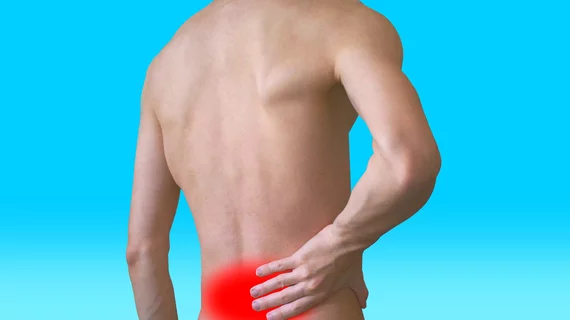Early PT for low back pain wards off advanced imaging, other pricey sources of healthcare spending
Patients who receive physical therapy for low back pain within two weeks of symptom onset pay significantly smaller healthcare bills at the 30-day and one-year marks than patients who wait longer for PT or never receive it, Johns Hopkins researchers have found.
Some of the biggest savings come from avoiding subsequent use of advanced imaging, the investigators note, as previous studies have shown lumbar MRI, for example, to spur additional tests and treatments.
They cite a 2010 study showing that MRI performed within a month after pain begins correlated with “greater risk of worse disability and higher medical costs and higher rates of surgery,” even for patients with pain of moderate to low severity.
“Therefore, for patients with low-back pain, early PT instead of imaging could decrease disability and spending,” remark the authors of the present study, which BMC Health Services Research published in July [1].
Corresponding author Richard Skolasky Jr., ScD, director of Johns Hopkins’s Spine Outcomes Research Center, and colleagues pursued the educated hunch that early PT—“early” defined as within two weeks of pain onset—would be associated with not only less advanced imaging but also fewer specialty appointments, emergency department visits and epidural steroid injections.
The team expected overall finding was lower total spending on downstream health measures related to low back pain.
They found that while also coming upon something of an anomaly.
Back-Pain-Specific Cost Analysis Skewed by Inclusion of PT Itself
To test their hypothesis, Skolasky and co-researchers analyzed records of around 980,000 adults who initially presented with acute low back pain caused by musculoskeletal factors.
Identifying around 110,000 patients (11%) who received early PT, they compared healthcare utilization and spending between early-PT patients and non-early-PT counterparts at both 30 days and one year following.
At 30 days, they found, early PT was associated with lower odds of chiropractor visits (odds ratio 0.41), pain specialist visits (odds ratio 0.49), emergency department visits (odds ratio 0.51), advanced imaging procedures (odds ratio 0.57), orthopedist visits (odd ratio 0.67) and epidural steroid injections (odds ratio 0.68).
Also at 30 days, patients with early PT had lower mean low back pain-related spending ($1180 ± $1500) compared with those without early PT ($1250 ± $2560).
And at one year, early PT was associated with lower healthcare utilization.
However, curiously, one-year spending related specifically to low back pain services was higher in the early PT group than in the group that did not receive early PT.
The authors surmise the anomalous finding owes to the inclusion of PT itself in the latter cost analysis.
Unclear Why Treatment Patterns Vary by Region
Also of interest, early PT rates and 30-day low back pain-related spending differed by state. Rhode Island had the highest rate of early PT, 25%, while Florida had the lowest, 4%.
Regionally, the West had the highest rate of early PT prescription (16%), followed by the Northeast (15%), Midwest (9.4%) and South (8.6%).
In their discussion, Skolasky et al. cite previous studies showing similar geographic variation in healthcare utilization tracing to low back pain, including referrals for advanced imaging.
“Although provider density has been shown to be related to utilization of low back pain services, it is unclear why treatment patterns vary by region,” they write. “Further research should examine the role that provider density, referral networks and other health system factors may play in the availability of early PT for patients with low back pain.”
In coverage of the study posted Aug. 2 by Johns Hopkins Medicine’s news division, Skolasky predicts an uptick in patients seeking relief from low back pain due to the aging of the population.
“Furthermore, with advances in imaging and treatments, the cost of managing lower back pain has increased substantially,” he says. “Our findings have important implications that may guide healthcare policy when examining downstream health care costs and resource utilization.”
The study is available in full for free.

